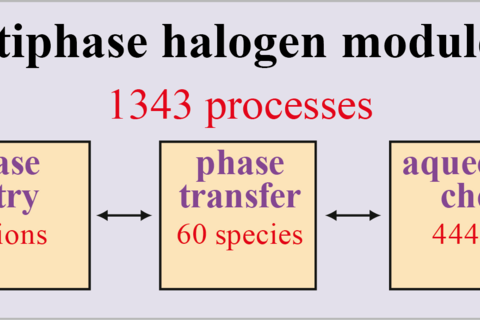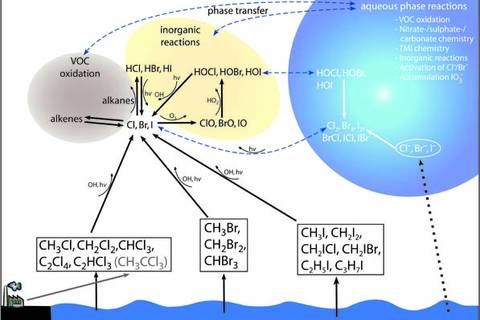Modelling the tropospheric halogen chemistry
Marine aerosol and its chemical processing has a significant impact on the global radiation budget and therefore on climate. Halogen species, i.e. chlorine, bromine and iodine compounds, are of particular importance in marine environments. The activation of chloride and bromide within sea-salt particles emitted from the ocean's surface forms the largest source for reactive halogen compounds in both, the gas and the aqueous phase. Direct emissions of alkyl halides from the ocean or, in coastal regions, from macroalgae during low tide form an additional source of halogens in the troposphere. Their photolysis or oxidation by radicals such as OH or NO3 leads to halogen atoms, which take part in several multiphase reaction cycles, where further halide ions in particles are activated, ozone is destroyed, or the tropospheric oxidation capacity is influenced.
To better understand the complex multiphase processes and their influence on environmental key issues such as air quality or climate change, sophisticated multiphase mechanisms for the description of the tropospheric halogen chemistry have been developed at the TROPOS.
The Halogen Module 3.0 (CAPRAMHM3.0; Hoffmann et al., 2019b), a mechanism specifically designed for marine halogen chemistry, can be modularly coupled to the MCM/CAPRAM multiphase chemistry mechanism (Bräuer et al., 2019; Hoffmann et al., 2019a and b). It is a further development of the Halogen Module 2.0 and 1.0 (Bräuer et al., 2013; Herrmann et al., 2003) and includes more than 1300 reactions in the gas and aqueous phase (see Fig. 1). The CAPRAMHM3.0 was designed for use in a wide variety of tropospheric boundary layer regions, that can range from pristine open ocean to urban polluted coastal areas at all latitudes on Earth. The processes processed in the Halogen Module 3.0 are shown in simplified form in Figure 2.
CAPRAMHM3.0 was used to drive comprehensive process studies using the SPACCIM (SPectral Aerosol Cloud Chemistry Interaction Model; Wolke et al., 2005) box model. The halogen cycles, halogen chemistry caused ozone depletion, interactions of reactive halogen species with other subsystems such as organic compounds and NOx in the gas and aqueous phase, or the influence on sulfur oxidation in the aqueous phase at polluted coastal areas were investigated (Hoffmann et al., 2019a and 2019b). The results of these simulations are of global importance, as coastal areas are home to about 40% of mankind and 3/4 of megacities with more than 10 million inhabitants are located there.
The simulations performed served as a basis to develop a reduced mechanism for use in the COSMO-MUSCAT chemical transport model (Hoffmann et al., 2020).
Publications:
Herrmann, H., Majdik, Z., Ervens, B., and Weise, D.: Halogen production from aqueous tropospheric particles. Chemosphere, 52(2), 485–502, DOI: 10.1016/S0045‑6535(03)00202‑9, 2003.
Bräuer, P., Tilgner, A., Wolke, R., and Herrmann, H.: Mechanism development and modelling of tropospheric multiphase halogen chemistry: The CAPRAM Halogen Module 2.0 (HM2), J. Atmos. Chem., 1-34, DOI: 10.1007/s10874-013-9249-6, 2013.
Hoffmann, E. H., Tilgner, A., Wolke, R., and Herrmann, H.: Enhanced chlorine and bromine atom activation by hydrolysis of halogen nitrates from marine aerosols at polluted coastal areas, Environ. Sci. Technol., 53, 771-778, DOI:10.1021/acs.est.8b05165, 2019a
Hoffmann, E. H., Tilgner, A., Vogelsberg, U., Wolke, R., and Herrmann, H.: Near-explicit multiphase modeling of halogen chemistry in a mixed urban and maritime coastal area, ACS Earth Space Chem., 3, 2452-2471, DOI:10.1021/acsearthspacechem.9b00184, 2019b.
Hoffmann, E. H., Schrödner, R., Tilgner, A., Wolke, R., and Herrmann, H.: CAPRAM reduction towards an operational multiphase halogen and dimethyl sulfide chemistry treatment in the chemistry transport model COSMO-MUSCAT(5.04e), Geosci. Model Dev., 13, 2587-2609, DOI:10.5194/gmd-13-2587-2020, 2020.


